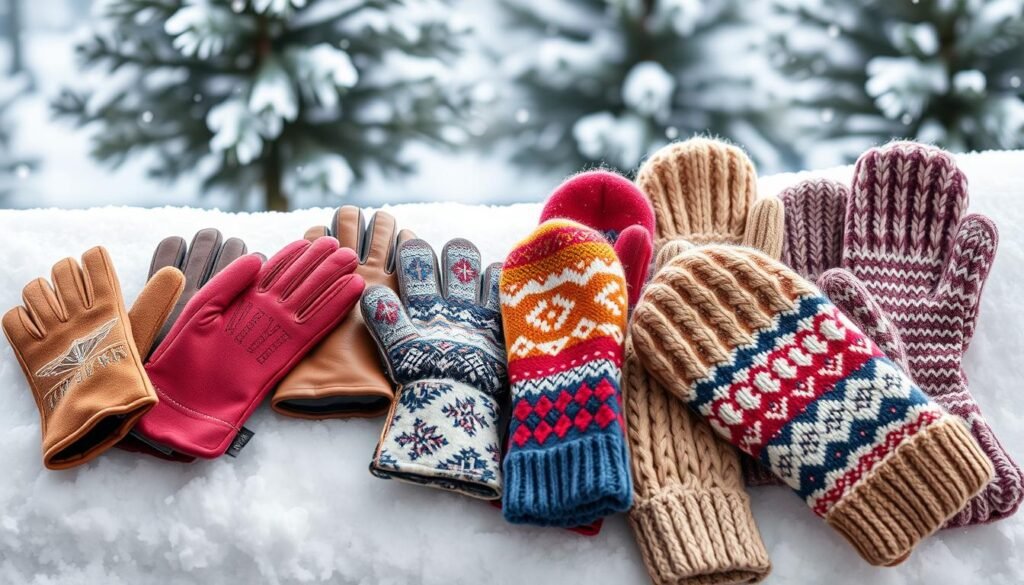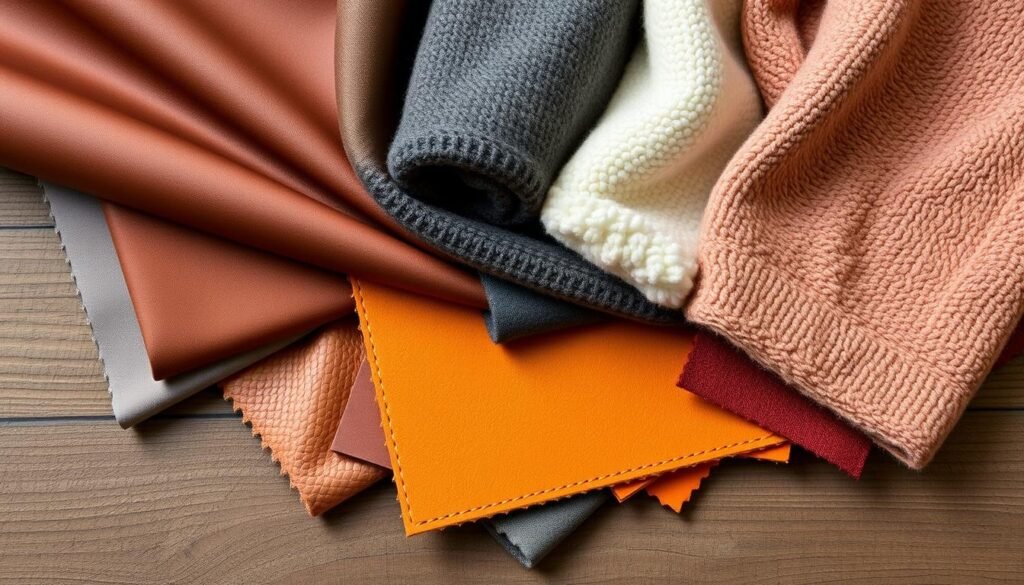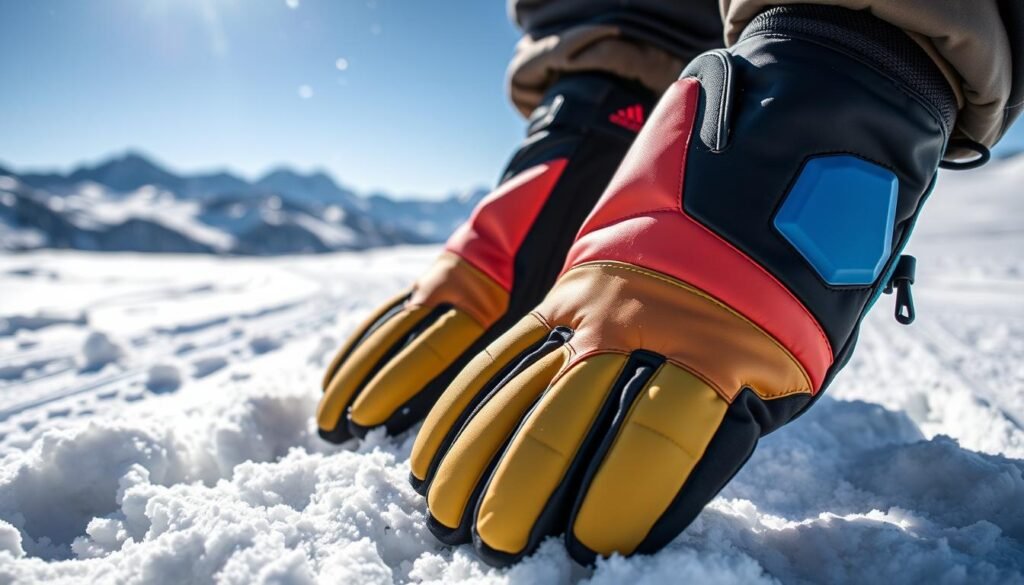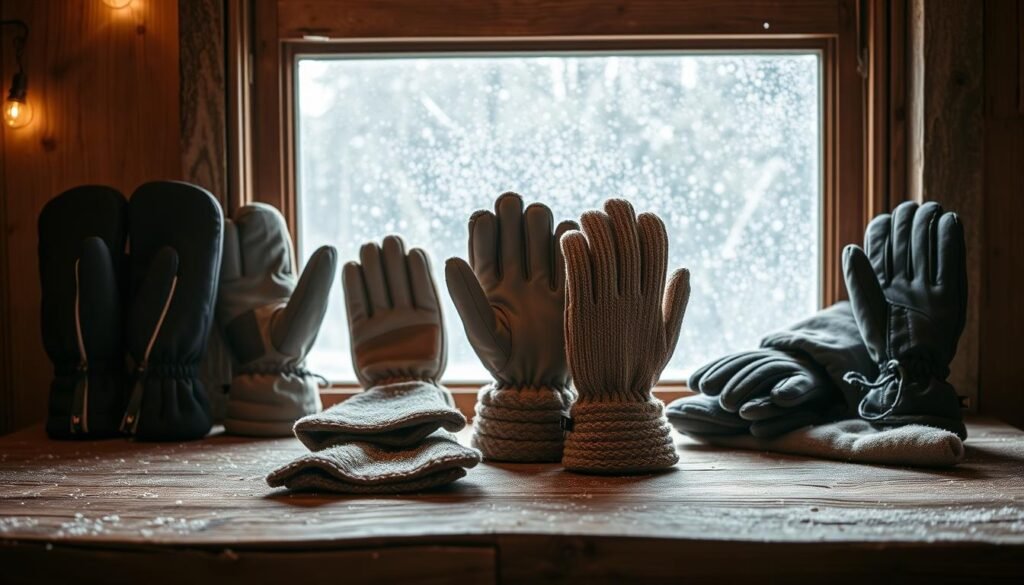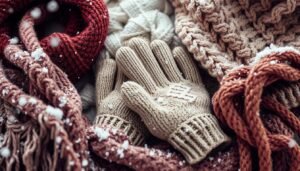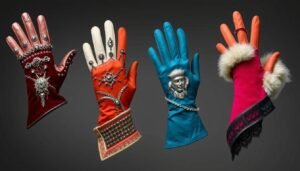When winter comes, choosing between gloves and mittens is key to staying warm. But what should you think about when picking the best winter handwear? Are gloves better than mittens, or is there more to it?
In this guide, we’ll look at the main differences between gloves and mittens. We’ll also dive into the science of keeping hands warm. Plus, we’ll share expert tips to help you find the perfect winter hand protection. Whether you love winter sports, work outside, or just want to stay cozy, this article will help you make the right choice and stay warm all season1.
Key Takeaways
- Mittens keep hands warmer by sharing body heat, but gloves are better for tasks needing fine motor skills.
- Insulation materials like Thinsulate are key for keeping hands warm in cold weather.
- Special mittens for skiing, snowboarding, and outdoor work offer both warmth and function.
- Getting the right fit and size is crucial for comfort and protection in winter handwear.
- Look for waterproofing, wind resistance, and durability when choosing winter handwear.
Understanding Winter Hand Protection Basics
Keeping hands warm in cold weather is key for both performance and safety. Several factors affect how our hands handle the cold. These include temperature, heat retention, and activity level. Knowing these basics helps pick the right winter hand protection.
How Temperature Affects Hand Comfort
As it gets colder, our hands get more sensitive. In fact, more than 25 joints are present in the wrists and hands combined2. Gloves help, but they don’t work well below 25 degrees Fahrenheit2.
The Science of Heat Retention
Keeping heat in is vital for hand warmth in cold. Mittens are better at thermal insulation than gloves. They let fingers share body heat. For example, the Skytec Argon glove stays flexible even at -50 degrees Celsius3.
Impact of Activity Level on Hand Warmth
Our activity level affects hand warmth. 70% of hand injuries happen after gloves have been removed3. But, the heat from activity can fight cold. This is crucial when picking winter hand protection for your needs.
Understanding these basics helps choose the best winter hand protection. This keeps your hands warm, comfortable, and safe, no matter the weather or activity.
Gloves or Mittens: Key Differences and Features
Choosing between gloves and mittens is crucial for winter hand protection. Gloves are great for tasks that need fine motor skills, like using phones or handling small items4. Mittens, on the other hand, are better at keeping hands warm in very cold weather5.
The design of gloves and mittens also matters. Gloves have features like cuffs and closures for better control6. Mittens focus on keeping hands warm with features like gauntlet-style wrist coverage6.
| Glove Features | Mitten Features |
|---|---|
| Better dexterity and finger mobility | Superior warmth by keeping fingers together |
| Cuffs, closures, and grip enhancements | Gauntlet-style wrist coverage for weather protection |
| Suitable for tasks requiring fine motor skills | Ideal for extremely cold conditions |
Choosing between gloves and mittens is about finding a balance between dexterity and warmth. Each has its own benefits for different winter activities and weather4. Knowing these differences helps pick the right hand gear for staying warm and able during winter4.
Material Innovations in Modern Handwear
The world of winter handwear has seen big changes in materials and tech. Now, gloves and mittens offer better performance and flexibility7.
Natural Materials: Leather, Wool, and Deerskin
Leather, wool, and deerskin are still top choices for warm and durable handwear. Leather is tough and keeps water out, great for outdoor lovers8. Wool keeps hands warm in cold weather. Deerskin is soft and breathable, perfect for a natural feel.
Synthetic Materials and Technologies
New synthetic materials have changed handwear. Thinsulate, for example, keeps hands warm without being heavy7. These materials manage moisture better and last longer than natural ones.
Waterproofing and Breathability Solutions
Keeping hands dry in bad weather is key. Gore-Tex and similar tech have made gloves and mittens better8. They let water out but keep air in, keeping hands dry and cool.
Choosing the right material is important for handwear. Knowing the differences between natural and synthetic helps find the best gloves or mittens78.
“The revolution in handwear materials has transformed the way we experience the outdoors, providing unparalleled protection and comfort in even the harshest winter conditions.”
| Material | Temperature Range | Chemical Resistance | Certification |
|---|---|---|---|
| Natural Latex Rubber | -20⁰C to 80⁰C (-4⁰F to 176⁰F) | Durable against a wide range of chemicals | ISO 9001:2015, ISO 14001:2015, PPE Regulation (EU) 2016/425, British Retail Consortium |
| Nitrile Gloves | -10⁰C to 100⁰C (14⁰F to 212⁰F) | High resistance to acids, bases, oils, grease, hydrocarbons, and petroleum derivatives | ISO 9001:2015, ISO 14001:2015, PPE Regulation (EU) 2016/425, British Retail Consortium |
| Neoprene Gloves | -20⁰C to 120⁰C (-4⁰F to 248⁰F) | High protection against aqueous acids and moderate protection against a wide range of chemicals | ISO 9001:2015, ISO 14001:2015, PPE Regulation (EU) 2016/425, British Retail Consortium |
Handwear materials have changed a lot, offering many choices. From natural fibers to synthetic insulation, the options are amazing789.
Anatomical Design and Comfort Considerations
Winter handwear’s design is key for comfort and function. Gloves and mittens with pre-curved fingers and joints help hands move naturally10. A good fit is also important for warmth and doing tasks well.
Materials like soft linings and moisture-wicking fabrics make cold weather more comfortable10. For stroke patients, gloves that fit their hand’s shape and movement are especially helpful.
- Ergonomic glove designs with pre-curved fingers and articulated joints for natural hand movements
- Soft, breathable linings and moisture-wicking properties for enhanced comfort
- Customized patterns and sizing to accommodate varying degrees of hand stiffness and range of motion
By focusing on design and comfort, makers of ergonomic gloves and comfort-fit mittens improve hand protection and dexterity10. This is true for winter sports, daily tasks, or professional use10.
“Clothing pressure is a quantitative indicator of wearable product comfort.”10
Research in hand anatomy and flexible handwear leads to better winter gloves and mittens1011.
| Metric | Accuracy |
|---|---|
| Estimating bone lengths | Mean error of 2.1 mm11 |
| Estimating joint angles | Mean error of 4.16 degrees11 |
| Estimating fingertip positions | Mean 3D error of 4.02 mm11 |
| Hand reconstruction error | Significant demand for improved accuracy11 |
| Fiducial localization error in da Vinci system | Approximately 1 mm11 |
| Kapandji score range for clinical thumb opposition assessment | 0 to 1011 |
By using these design and comfort advances, makers can create top-notch ergonomic gloves and comfort-fit mittens. These products improve the user experience for winter lovers and professionals1011.
Activity-Specific Handwear Selection
Winter handwear isn’t one-size-fits-all. Different activities need special features for comfort, dexterity, and protection. Whether skiing, exploring the city, or working hard, the right gloves or mittens are crucial.
Winter Sports and Recreation
For winter sports fans, durability and weather resistance are key. Ski gloves and mittens are made to handle skiing, snowboarding, and ice climbing. They have strong palms, tough fabrics, and keep water out12.
Mittens are better for young kids starting with skiing. They keep fingers together, sharing warmth12. As kids get older and better at using their hands, gloves are a better choice for them12.
Daily Urban Use
In the city, style and being able to use touchscreens matter. Urban winter gloves are sleek, stylish, and work with phones and tablets. They’re great for daily activities like commuting or running errands.
Professional and Work Applications
At work, handwear needs to protect and grip well. Work mittens and gloves keep hands safe, offer dexterity, and a good grip on tools. They’re vital for jobs like construction, mechanics, or outdoor work.
| Handwear Type | Price Range | Insulation Material |
|---|---|---|
| Best Overall Ski Glove (Hestra Army Leather Heli Glove) | $16013 | G-Loft synthetic & fleece13 |
| A Close Second Glove (Black Diamond Guide Glove) | $18013 | PrimaLoft One (170g) & wool13 |
| Best Overall Ski Mitten (Black Diamond Mercury Mitt) | $12013 | PrimaLoft Gold (133 & 170g)13 |
| Best Budget Ski Glove (Gordini GTX Storm Glove) | $7513 | Polyester13 |
| Best Budget Ski Mitten (Outdoor Research Revolution Gore-Tex Mitt) | $8913 | EnduraLoft (200g)13 |
| Best Heated Ski Glove (Outdoor Research Prevail Heated GTX Gloves) | $33913 | EnduraLoft (133 & 333g) & AltiHeat system13 |
Whether skiing, city exploring, or work tasks, the right handwear is key. Knowing what each activity needs ensures your hands stay warm, safe, and comfortable all winter.
Insulation Technologies and Warmth Ratings
Keeping your hands warm in winter depends on the insulation in your gloves or mittens. Today, you can choose from thermal insulation like synthetic fills or natural down. These options are perfect for any cold-weather activity14.
The warmth-to-weight ratio is key when picking insulation. Heavy gloves might keep you warm but can be stiff and hard to move. Now, there are slim, high-tech gloves that stay warm without feeling bulky14.
Top brands give clear warmth ratings to help you pick the right insulated gloves or heat-retention mittens. They rate warmth in degrees Fahrenheit or use a scale within their line14.
For really cold weather, look for gloves with heat-reflective linings or battery-powered heating. These features provide unmatched warmth14. They’re perfect for facing harsh wind and snow14.
Whether skiing, commuting, or doing outdoor work, the right insulation is crucial. Knowing about the latest thermal insulation and warmth ratings helps you choose. This way, you can keep your hands warm and safe all winter141315.
Sizing and Fit Guidelines
Finding the right glove or mitten size is key for winter hand protection. The correct size offers the best insulation, dexterity, and comfort. This lets you perform well in outdoor activities and cold weather16.
Measuring for Perfect Fit
To get your ideal glove or mitten size, measure your hand accurately. Start by tracing your hand on paper. Then, measure the widest part of your palm and the length from the base of your palm to the tip of your longest finger16. Ansell, a top maker of protective handwear, has gloves from Small to XXL. Sizes range from 6.5 – 7 inches for size 7 to 10.5 – 11 inches for size XXL16.
Accommodating Additional Layers
When wearing a liner glove or mitten, think about the extra space needed. Choose a slightly larger size for comfort over the extra layer. This keeps your hands warm and safe as the temperature goes down.
Common Sizing Mistakes to Avoid
Don’t pick oversized gloves for warmth, as they can reduce insulation and dexterity17. Gloves that don’t fit right can lead to accidents, as they might slip off or affect your grip17. Many workers, especially women in trades, have trouble finding gloves that fit well17.
| Glove Sizing Factors | Considerations |
|---|---|
| Hand Measurements | Measure the widest part of your palm and the length from the base of your palm to the tip of your longest finger. |
| Layering Needs | Choose a slightly larger size to accommodate a liner glove or mitten for added warmth. |
| Industry and Activity | Select gloves designed for your specific work or recreational needs, such as ANSI/ISEA impact protection or chemical resistance. |
“Protective gloves can reduce hand injuries by up to 60%, but 70% of hand injuries are caused by workers wearing inadequate or incorrect gloves.”17
Getting the right glove and mitten size is key for comfort, dexterity, and protection in cold weather. By knowing how to measure your hands and account for extra layers, you can avoid common mistakes. This ensures you find the perfect fit for your winter hand protection needs1617.
Maintenance and Care Tips
Proper care and maintenance are key to making your winter handwear last longer. Whether you have leather gloves, wool mittens, or synthetic handgear, the right cleaning and storage can greatly improve their performance and durability18.
Leather gloves need different cleaning methods based on their type. Full-grain leather is very durable but needs special care. Top-grain leather and genuine leather are less durable and may need more complex cleaning18. Handwashing is usually the best way to clean most leather gloves. But, suede leather needs extra care and caution18.
It’s important to dry gloves and mittens the right way to keep them warm and weather-resistant. Always let them air-dry naturally, away from heat and sunlight. Using a leather conditioner after cleaning can also help keep the leather soft and prevent it from drying out18.
If you prefer an easy option, services like Clotheslyne can wash, dry, and fold your clothes and bulky items, including gloves and mittens. They offer expert cleaning and a quick 48-hour turnaround, saving you time and ensuring your handwear is well-cared for.
By following these simple care tips, you can keep your winter gloves and mittens in great shape. This way, they will provide reliable warmth and protection all winter long18.
Weather Resistance and Durability Features
Winter handwear needs to be weatherproof and durable14. Gloves and mittens keep your hands warm, dry, and safe from harsh winter weather.
Waterproofing Technologies
Materials like Gore-Tex and DWR coatings keep moisture out14. They let your hands breathe while keeping them dry in wet conditions.
Wind Protection Elements
Wind-resistant materials and designs block cold air14. They keep your hands warm and protected from winter winds.
Reinforcement Zones
Manufacturers add reinforcement zones in high-wear areas14. These areas, like palms and fingertips, last longer and provide better protection.
| Product | Price | Warmth Score | Waterproofing | Wind Protection | Reinforcement |
|---|---|---|---|---|---|
| Outdoor Research GORE-TEX Revolution Mitten | $89 | 8/10 | GORE-TEX | Yes | Reinforced Palm |
| Give’r Frontier Mittens | $139 | 8.5/10 | Water-Resistant | Yes | Reinforced Knuckles and Palm |
| Outdoor Research Alti II GORE-TEX Mitts | $209 | 8.5/10 | GORE-TEX | Yes | Reinforced Palm and Fingers |
Weather-resistant handwear protects your hands from harsh winter conditions14. Investing in quality gloves or mittens means you can enjoy the outdoors all winter.
“The most important aspects of winter handwear are the ability to keep your hands warm, dry, and protected from the elements. Waterproofing, wind resistance, and reinforcement zones are crucial features that ensure your hands remain comfortable and safe, no matter the conditions.”
Price Points and Value Considerations
Winter handwear prices vary a lot. Budget gloves give basic protection, while premium mittens have advanced features and materials19. The cost depends on insulation quality, weather resistance, and brand20.
When looking at winter handwear value, think beyond the price. Durability, performance, and use are key. Cost-effective handwear might not be the cheapest but offers great value for money19.
| Product | Overall Score | Warmth | Dexterity | Water Resistance | Durability |
|---|---|---|---|---|---|
| Arc’teryx Fission SV ski glove | 82 | 7.0 | 8.0 | 10.0 | 8.0 |
| Black Diamond Mercury Mitts | 64 | 8.0 | 2.0 | 8.0 | 8.0 |
| Gordini GTX Storm Trooper II | 69 | 7.0 | 4.0 | 8.0 | 8.0 |
| The North Face Montana Ski Mitts | 61 | 8.0 | 2.0 | 8.0 | 8.0 |
| Outdoor Research Prevail Heated Gore-Tex Gloves | 81 | 10.0 | 5.0 | 9.0 | 9.0 |
The table shows premium mittens and investment winter gear are pricier but better in quality and durability19. It’s important to think about your needs and use to choose the best value20.
“Finding the right balance between price and value is essential when selecting winter handwear. It’s not just about the upfront cost, but the long-term performance and durability that matter most.”
Consider insulation, weather resistance, and brand reputation to make smart choices. This way, you can find budget gloves or premium mittens that offer great value for your money1920.
Conclusion
Choosing the right winter handwear is all about finding a balance. You need warmth, dexterity, and the right fit for your activities21. Mittens keep fingers together for more warmth, and liners can add extra insulation21.
The trend is moving towards mittens because they are warmer than gloves1. Companies like Hand Armor Gloves and Trading see this shift. They focus on making mittens that keep hands warm1.
Modern handwear also comes with new materials. You can find leather, deerskin, or synthetic options that are waterproof and breathable1. It’s important to think about how they fit and feel. Also, consider what you’ll be doing with them21.
Knowing how to care for your handwear is key. This includes checking the insulation, getting the right size, and following care tips21.
By learning about winter handwear, you can make a smart choice. You’ll know which is better for you: winter handwear choice, gloves vs mittens decision, and cold weather hand protection211.
FAQ
How do temperature and activity level affect the choice between gloves and mittens?
Hand comfort in winter depends on temperature, wind chill, and moisture. Mittens keep hands warmer than gloves because they cover fingers together. If you’re active, gloves might be better for tasks needing fine motor skills. But for extreme cold, mittens are the better choice.
What are the key differences in features between gloves and mittens?
Gloves let you move your fingers freely, great for tasks that need precision. Mittens, on the other hand, are warmer because fingers are together. Both types have different features like cuffs and grip enhancements, affecting how well they work in various situations.
What are the different materials used in modern winter handwear?
Leather and wool are natural materials that keep hands warm and last long. Synthetic materials like Thinsulate are light and insulate well. Waterproofing technologies, like Gore-Tex, keep hands dry while letting them breathe. The material used greatly affects how well gloves and mittens perform.
How does the anatomical design of gloves and mittens affect comfort and functionality?
Designs like pre-curved fingers and ergonomic palms make gloves and mittens more comfortable. A good fit is key for both warmth and dexterity. Features like soft linings and moisture-wicking materials also improve comfort in cold weather.
What are the different features and considerations for winter handwear based on activity?
For winter sports, handwear needs to be durable and weather-resistant. In cities, style and touchscreen compatibility are more important. For work, protection and grip are crucial. Specialized gloves and mittens exist for activities like skiing and ice climbing, offering specific features.
How do insulation technologies and warmth ratings affect the choice of winter handwear?
Insulation in gloves and mittens can be synthetic or natural. Warmth ratings help pick the right handwear for different temperatures. New technologies like heat-reflective linings and heated systems provide extra warmth in extreme cold.
How can you ensure a proper fit for gloves and mittens?
Getting the right size is essential for gloves and mittens to work well. Measure your hands accurately for a snug fit. Avoid oversized gloves for warmth, as they can reduce insulation and dexterity.
What are the best practices for maintaining and caring for winter handwear?
Proper care extends the life of winter handwear. Cleaning methods vary by material, with leather needing special care. Regular waterproofing keeps them weather-resistant. Dry them right to avoid damage and keep them insulating. Store them properly to keep them in good shape for next season.
What are the key weather resistance and durability features to look for in winter handwear?
Weather resistance is key for winter handwear. Look for waterproofing like Gore-Tex and DWR coatings. Materials and designs that block wind are also important. Reinforced areas like palms and fingertips make them last longer.
How do price points and value considerations factor into the selection of winter handwear?
Winter handwear comes in many price ranges. Budget options offer basic protection, while high-end products have advanced features. Price is influenced by insulation, weather resistance, and brand reputation. Value comes from durability, performance, and intended use, helping make a cost-effective choice.
Source Links
- https://handarmorgloves.com/mittens-vs-gloves-why-mittens-are-the-ultimate-winter-handwear/
- https://upmcnj.com/bare-necessities-combating-arthritis-in-winter/
- https://globusgroup.com/newsroom/winter-hand-protection-guide
- https://www.treelinereview.com/gearreviews/best-winter-gloves
- https://www.switchbacktravel.com/best-snowboard-gloves-mittens
- https://www.nytimes.com/wirecutter/reviews/best-ski-and-snowboard-gloves/
- https://10moresocks.com/the-evolution-of-golf-hand-protections-from-vintage-to-modern-styles/
- https://www.dplgroup.com/blog/the-comprehensive-guide-to-natural-latex-and-synthetic-rubber-gloves/
- https://www.livingstone.com.au/knowledge-hub/2024/08/08/the-evolution-of-gloves-in-healthcare/?srsltid=AfmBOoqGrceNiKwylyKWKeXHdDcTPJoTcjDWHgKItJFxlIkROQsQBDvU
- https://fashionandtextiles.springeropen.com/articles/10.1186/s40691-024-00397-5
- https://pmc.ncbi.nlm.nih.gov/articles/PMC11237015/
- https://thatslaplagne.com/ski-gloves-or-mittens-for-ski-kids/
- https://www.switchbacktravel.com/best-ski-gloves-mittens
- https://gearjunkie.com/winter/world-s-best-winter-mitts
- https://www.outdoorgearlab.com/topics/snow-sports/best-winter-gloves
- https://www.ansell.com/us/en/blogs/safety-briefing/na/how-to-measure-glove-size
- https://www.wondergrip.com/en/insights/are-your-gloves-the-right-fit-for-you/
- https://www.clotheslyne.com/blog/how-to-wash-leather-gloves/
- https://www.outdoorgearlab.com/topics/snow-sports/best-ski-gloves
- https://www.wired.com/gallery/best-ski-gloves-and-mittens/
- https://underbudgetadventure.com/mittens-vs-gloves-for-skiing/

